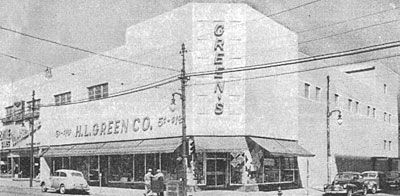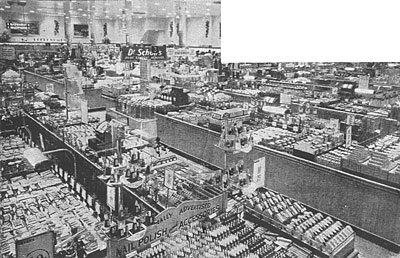
Category: default || By jt3y
Old photo time at Tube City Almanac! By my recollection, this year marks the 20th anniversary of the demolition of the old H.L. Green Co. store at the corner of Fifth and Walnut in Downtown Our Fair City.

Green's was a chain of variety stores --- five-and-10s --- much in the manner of G.C. Murphy Co. or F.W. Woolworth Co. Founded by former auto company executive Harold L. Green, it arrived on the dime-store scene fairly late --- 1932. (Most of its competitors had roots that went back to the 19th century.) Green's, therefore, was never one of the largest variety store companies, but it was very successful and profitable for a number of years, and it grew quickly by absorbing a number of other chains.
This made the demise of the H.L. Green Co. name all the more ironic. Green's, through a subsidiary, acquired a large share of stock in two of its competitors --- McCrory Stores and McClellan Stores. Through a complicated series of stock swaps, all three chains wound up merging, but the McCrory Stores gained control of the operation.
But Green's executives continued to rise to positions of prominence in the new organization, which for a short time was known as "McCrory-McLellan-Green." Indeed, one of the last presidents of McCrory Stores was a former H.L. Green store manager J. Philip Lux. Besides being a leading executive in the retail business for many years, Lux was also a minor footnote to major American history; he was the manager of the Green's store in Dallas, Texas, in 1964, and was subpoenaed to testify before the Warren Commission that his store had not sold Lee Harvey Oswald the rifle used to shoot President Kennedy. (Of note to McKeesporters: Lux was the man who years later engineered the purchase of the G.C. Murphy Co. five-and-10s from Ames Department Stores in 1989, which led to the final closing of the Murphy office in Our Fair City.)
In any event, I don't have any idea when H.L. Green opened its first store in Our Fair City, but I've seen reference to an earlier "Metropolitan Store" being located Downtown, which was one of the chains that Green's purchased. In the mid-1940s, the Green's store burned down. Green's then cleared several buildings on the north side of the 200 block of Fifth Avenue for one of the company's largest stores. It opened in 1949. (These photos are from a 1950 feature in the magazine Chain Store Age.)
The corner entrance was (naturally) at the corner of Fifth and Walnut. The long side of the store, with the display windows, was along Fifth Avenue, Our Fair City's main commercial thoroughfare for many years. At the time the store opened, the other corners would have been occupied by People's Union Bank, the then-closed White's Opera House, and First National Bank of McKeesport. White's was torn down in the mid-1950s to make way for Cox's, which was itself torn down 40 years later.
Green's closed their McKeesport store in the early 1980s, and the property was sold and the relatively-new building was torn down so the lot could be used as a Sheetz convenience store. Sheetz didn't last long, selling the store to Belle Vernon's Guttman Oil Co. for use as a "CrossRoads" convenience store, which was transformed into a "GetGo" a few years ago. But when it first opened, many people considered Green's to be a nicer store inside than the G.C. Murphy store and the F.W. Woolworth in the next block!

Of course, I may be biased; my maternal grandmother was a longtime sales girl, assistant manager and floorwalker at H.L. Green's, retiring a short time before the store closed.
Thanks for the history lesson on the five-and-dimes and McKeesport.
I have a Tube City brain teaser: Where were the old railroad tracks that ran through town located?
Who owned them and when and why were they removed?
Jonathan Barnes - May 26, 2005
You’ve come to the right place, because the Tube City information booth is always open for business.
The railroad tracks were owned by the Baltimore & Ohio Railroad (now part of CSX). The tracks ran up the Youghiogheny River, under the 15th Avenue Bridge, and then into the Third Ward between Market and Walnut streets.
At around St. Peter’s Church, they started to curve east through Downtown, crossing behind Cox’s and Immel’s and over Fifth Avenue, where the train station was (roughly the current site of Midtown Mall). The tracks then crossed Lysle Boulevard and ran alongside the Pittsburgh & Lake Erie railroad.
They were removed in 1970.
More here:
http://mckeesport.dementia.org/history/b&ocross.html
Webmaster (URL) - May 26, 2005
Thanks for the help.
Jonathan Barnes - May 26, 2005
To comment on any story at Tube City Almanac, email tubecitytiger@gmail.com, send a tweet to www.twitter.com/tubecityonline, visit our Facebook page, or write to Tube City Almanac, P.O. Box 94, McKeesport, PA 15134.